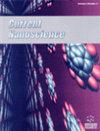Nanoencapsulation of Zataria multiflora Essential Oil Containing Linalool Reduced Antibiofilm Resistance against Multidrug-resistant Clinical Strains
IF 1.5
4区 材料科学
Q4 BIOTECHNOLOGY & APPLIED MICROBIOLOGY
引用次数: 0
Abstract
Background: The rise in antimicrobial resistance, caused by the production of biofilms by bacteria, is a significant concern in the field of healthcare. Nanoemulsion technology presents itself as a viable alternative in the quest to circumvent antibiotic resistance in pathogenic bacteria. Objective: The aim of this research was to form a sustainable nanoemulsion from Z. multiflora, and evaluate its antibacterial and anti-biofilm activities against the clinical isolates of Pseudomonas aeruginosa, Proteus mirabilis, and Staphylococcus aureus. Materials and Methods: Bioactive compounds of the oil were identified using GC-MS. Zataria multiflora essential oil (ZMEO) nanoemulsion was formulated as a water-dispersible nanoemulsion with a diameter of 184.88 ± 1.18 nm. The antibacterial and antibiofilm activities of the essential oil in both pure and nanoemulsion forms were assessed against pathogenic bacteria causing hospital-acquired infections using minimal inhibitory concentrations (MICs) and the microtiter method, respectively. Results: The main constituents were found to be linalool (78.66 %), carvacrol (14.25 %), and α- pinene (4.53%). Neither ZMEO nor the emulsified ZMEO showed any antimicrobial activity. However, ZMEO exhibited a low inhibition of biofilm formation by P. mirabilis, S. aureus, and P. aeruginosa. The most promising finding was that when the emulsified ZMEO was present at a concentration of 750 μg/mL, it significantly reduced biofilm formation by the aforementioned bacteria to 39.68% ± 2.62, 56.54% ± 3.35, and 59.60% ± 2.88, respectively. This result suggests that ZMEO nanoemulsion has the potential to effectively disrupt persistent biofilms and enhance the penetration of antimicrobial agents into the biofilm matrix. Conclusion: In conclusion, the study provides evidence supporting the use of ZMEO nanoemulsion as a potential treatment option for combating biofilm-related infections caused by Pseudomonas aeruginosa, Proteus mirabilis, and Staphylococcus aureus. Further research is warranted to explore the practical application of the proposed essential oil in clinical settings.含芳樟醇的多花月见草精油纳米胶囊降低了耐多药临床菌株的抗生物膜耐药性
背景:细菌产生生物膜导致的抗菌药耐药性上升是医疗保健领域的一个重大问题。纳米乳液技术是规避病原菌抗生素耐药性的一种可行选择。研究目的本研究的目的是从多花金银花中提取可持续纳米乳液,并评估其对铜绿假单胞菌、奇异变形杆菌和金黄色葡萄球菌临床分离株的抗菌和抗生物膜活性。材料与方法:使用气相色谱-质谱鉴定精油中的生物活性化合物。多花月见草精油(ZMEO)纳米乳液配制成水分散纳米乳液,直径为 184.88 ± 1.18 nm。采用最小抑菌浓度(MICs)和微滴定法,分别评估了纯精油和纳米乳液对引起医院感染的病原菌的抗菌和抗生物膜活性。结果显示发现其主要成分为芳樟醇(78.66%)、香芹酚(14.25%)和α-蒎烯(4.53%)。ZMEO 和乳化 ZMEO 都没有显示出任何抗菌活性。不过,ZMEO 对奇异变形杆菌、金黄色葡萄球菌和绿脓杆菌形成生物膜的抑制作用较低。最有希望的发现是,当乳化 ZMEO 的浓度为 750 μg/mL 时,它能显著减少上述细菌的生物膜形成,分别为 39.68% ± 2.62、56.54% ± 3.35 和 59.60% ± 2.88。这一结果表明,ZMEO 纳米乳液具有有效破坏顽固生物膜和增强抗菌剂对生物膜基质渗透的潜力。结论总之,本研究提供的证据支持使用 ZMEO 纳米乳液作为一种潜在的治疗方案,来对抗铜绿假单胞菌、奇异变形杆菌和金黄色葡萄球菌引起的生物膜相关感染。我们有必要开展进一步的研究,探索所提议的精油在临床环境中的实际应用。
本文章由计算机程序翻译,如有差异,请以英文原文为准。
求助全文
约1分钟内获得全文
求助全文
来源期刊

Current Nanoscience
工程技术-材料科学:综合
CiteScore
3.50
自引率
6.70%
发文量
83
审稿时长
4.4 months
期刊介绍:
Current Nanoscience publishes (a) Authoritative/Mini Reviews, and (b) Original Research and Highlights written by experts covering the most recent advances in nanoscience and nanotechnology. All aspects of the field are represented including nano-structures, nano-bubbles, nano-droplets and nanofluids. Applications of nanoscience in physics, material science, chemistry, synthesis, environmental science, electronics, biomedical nanotechnology, biomedical engineering, biotechnology, medicine and pharmaceuticals are also covered. The journal is essential to all researches involved in nanoscience and its applied and fundamental areas of science, chemistry, physics, material science, engineering and medicine.
Current Nanoscience also welcomes submissions on the following topics of Nanoscience and Nanotechnology:
Nanoelectronics and photonics
Advanced Nanomaterials
Nanofabrication and measurement
Nanobiotechnology and nanomedicine
Nanotechnology for energy
Sensors and actuator
Computational nanoscience and technology.
 求助内容:
求助内容: 应助结果提醒方式:
应助结果提醒方式:


